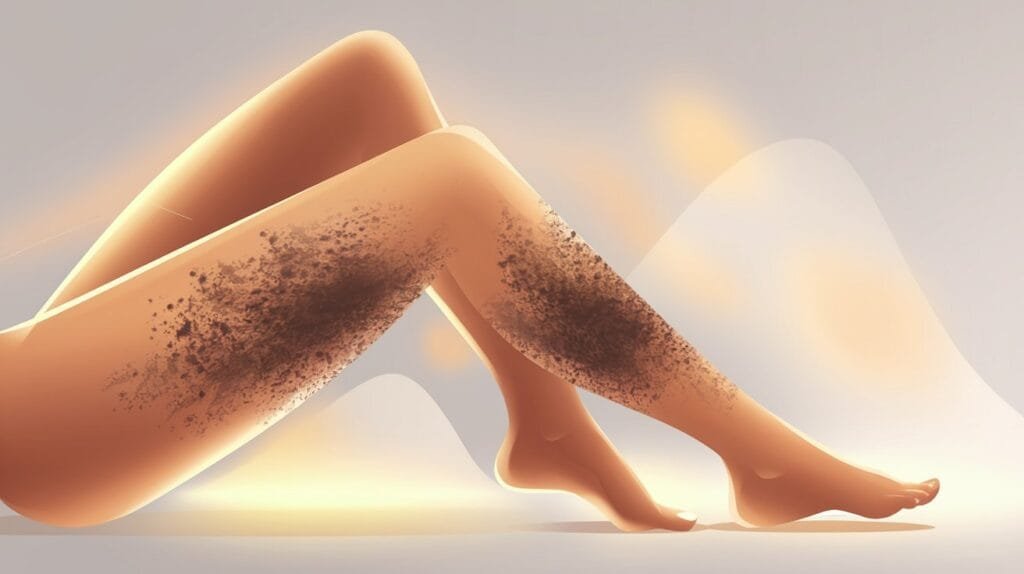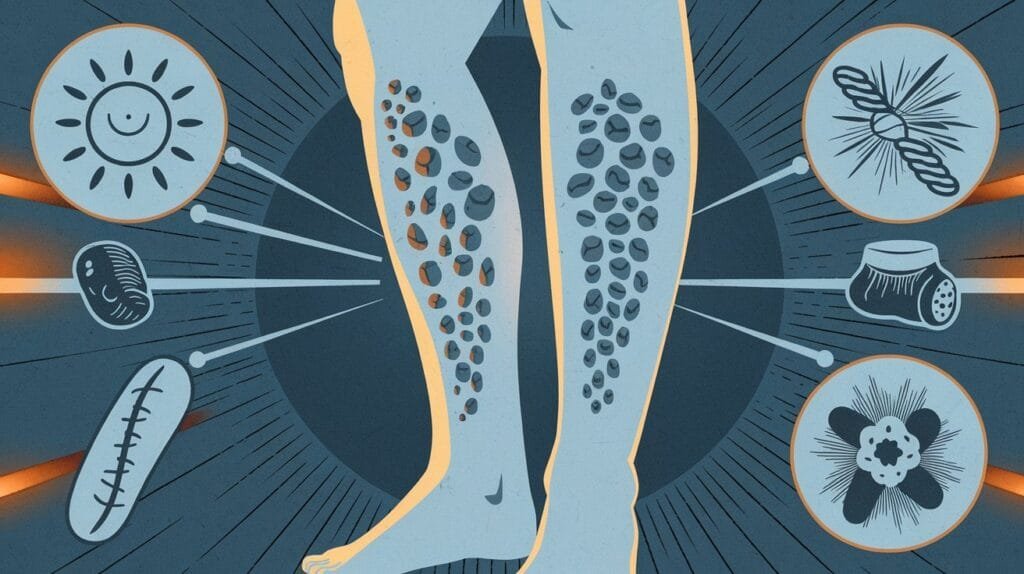
Have you spotted those ugly black patches on your legs? You’re not alone. This prickly skin problem plagues many, leaving you to wonder if there’s a remedy. Good news! In this blog, we will discuss safe yet effective treatments for clearing your skin. Keep watching to reveal beauty hacks dermatologists adhere to.
Fade Dark Spots on Legs in Just a Week
Introduction
Dark spots on legs or hyperpigmentation are a common, cosmetic skin issue, that many of us suffer. These blemished patches can emerge for many different reasons, and typically evoke a sense of urgency or embarrassment. To help you better understand these skin conditions, we consulted leading dermatologists.
Dark Spots on Skin by Dermaflora — dark spots on skin can affect your confidence and self-esteem, so its important to take care of your skin for healthy appearance. This article discusses the causes, prevention, home remedies, and professional treatment for dark spots on legs.
Causes of Dark Spots

Sun Exposure
Long-term exposure with ultraviolet (UV) rays is one of the leading causes of dark patches on the legs. Sun exposure makes your skin produce more melanin, causing darker patches to appear on your skin.
Hormonal Changes
Hormones, well known to fluctuate also during pregnancy or by means of certain medications, can induce the creation of dark spots.
Aging Process
Our skin, in time, certainly is more prone to discoloration because of years in the sun, plus a slowdown in our skin’s ability to renew itself.
Post-inflammatory Hyperpigmentation due to trauma
Inflammation caused by injuries, insect bites, or skin conditions like eczema can darken the skin as the area heals.
Prevention Tips

Sunscreen Use
To prevent dark spots, apply a broad-spectrum sunscreen with at least SPF 30 to any skin that will be exposed to the sun.
Protective Clothing
Long pants, skirts, and long-sleeve or UV-protective clothing will help protect your legs from the sun.
Regular Skin Care Routine
Regular skincare routine with gentle cleansing and exfoliation can treat uneven skin tone.
Healthy Diet Impact
Eating foods that are high in antioxidants and vitamins can support skin health and may help prevent dark spots.
Home Remedies

Lemon Juice And Honey Mask
- Mix 2 equal parts of lemon juice and honey
- Leave on dark spots for 15-20 min
- Rinse with lukewarm water
- Use 2-3 times a week
Aloe Vera Application
- Use fresh aloe vera gel straight from a leaf.
- Apply to areas of hyperpigmentation
- Apply and leave on for 30 minutes before rinsing
- You can repeat it for better results every day.
Turmeric and Milk Paste
- Mix 1 teaspoon of high-quality turmeric powder with 2 tablespoons of warm milk.
- Use a paste and apply it to the affected areas.
* Leave it on for 20 minutes and rinse - Use 3-4 times a week
Oatmeal and Buttermilk Exfoliating Scrub
- Combine 2 tablespoons oatmeal with 1 tablespoon buttermilk
- Scrub the dark spots gently in circular motions
- Rinse after 10 minutes
- Use twice a week
Medical Treatments

Active Ingredients in Topical Creams
Over-the-counter or prescription creams with ingredients such as hydroquinone, kojic acid, or vitamin C may work to lighten dark spots.
Chemical Peels
Deep chemical peels in a professional setting work differently and remove the outer layer skin to stimulate skin cell turnover to reduce dark spots.
Laser Therapy Options
Different laser therapies, such as those that target melanin — which dark spots contain — can help lighten them.
Benefits of Microdermabrasion
“This process lightly exfoliates the skin’s surface, allowing for the gradual improvement of dark spots.”
When to See a Doctor
Persistence or Proliferation of Spots
If dark spots do not fade despite home treatment or begin to spread, see a dermatologist.
Changes in Texture or Pain
Changes in the texture of dark spots or pain in association with them require medical attention.
Warning Signs of Skin Cancer
Know the ABCDE rule for melanoma: Asymmetry, Border irregularity, Color change, Diameter increase, and what is Evolving. Get medical evaluation right away if you notice these signs.
Conclusion
Dark spots on legs are a common concern that can be addressed through a combination of prevention, at-home remedies, and professional treatments. Knowing why it happens and how you can care for your skin can improve its look and help you feel more confident.
Keep in mind that patience is a virtue when treating dark spots, this is not something that will happen overnight. However, if the dark spots are persistent, or you are concerned, you should contact a dermatologist for appropriate recommendations and treatment.
Investing in your skin is an investment in your health. Allow your skin time to heal, and acknowledge the improvement you see on the journey.


